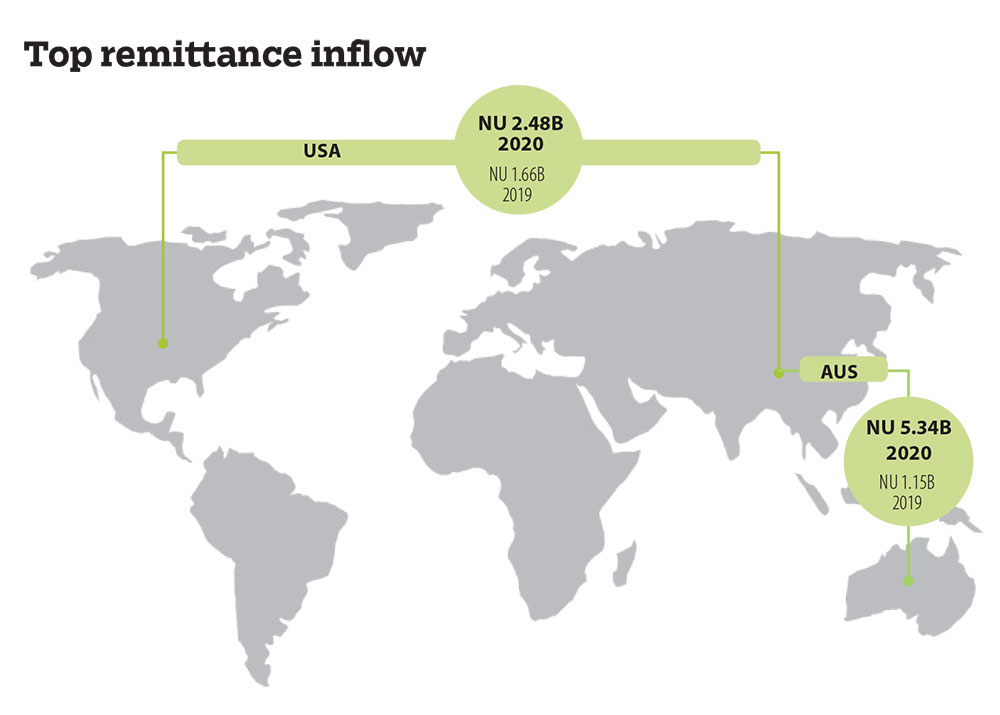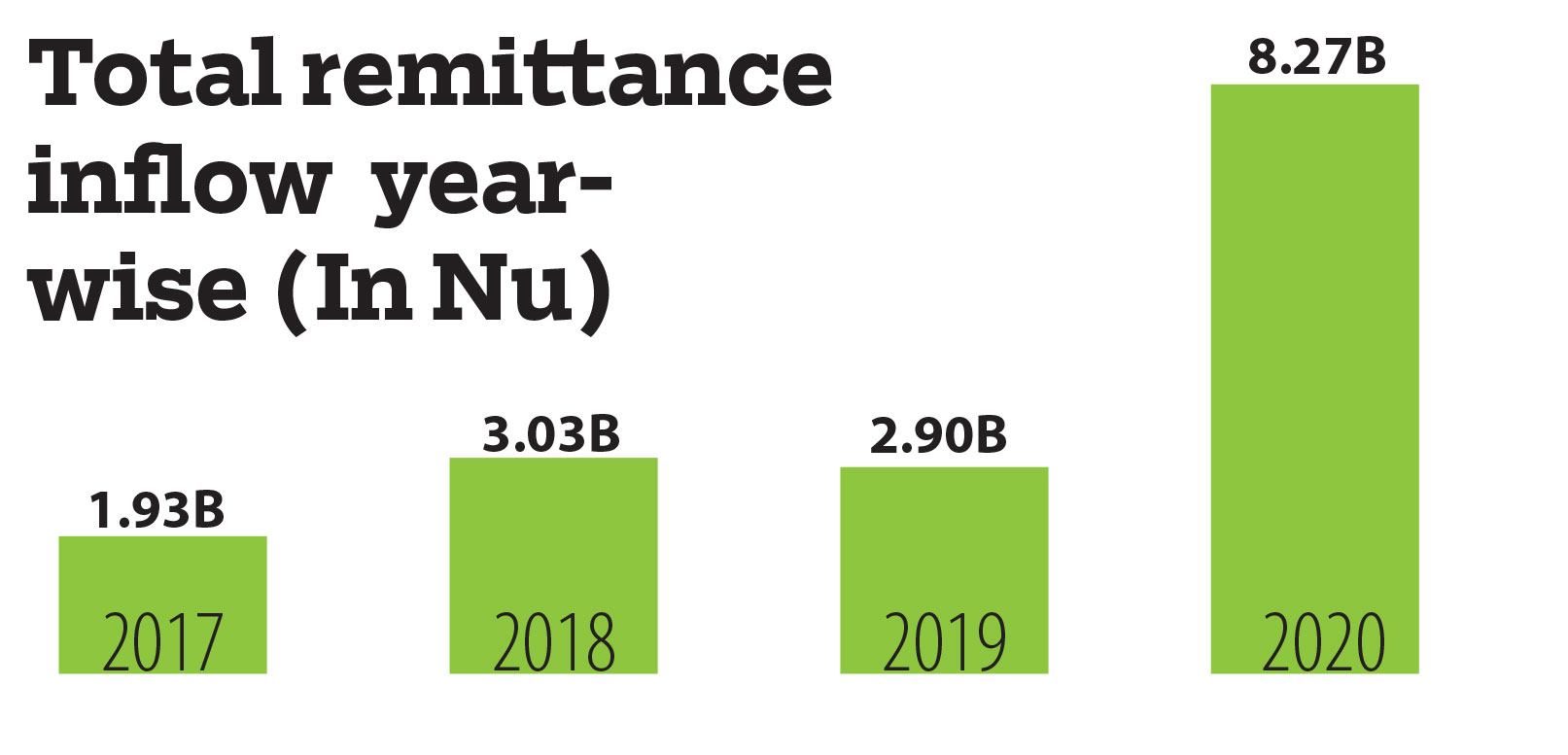The amount was higher than the combined remittance of the past three years
Thukten Zangpo
At Nu 8.27 billion (B), remittance inflow in 2020 contributed about 4.82 percent to the gross domestic product (GDP), making it the highest remittance inflow so far. The amount is more than the remittance of the past three years combined.
Remittance in 2017, 2018, and 2019 amounted to Nu 7.8B, according to the Royal Monetary Authority’s (RMA) October monthly statistical bulletin. Remittance inflow in 2017, 2018, and 2019 was Nu 1.9B, Nu 3B and Nu 2.9B respectively.
Remittance is a transfer of money by a foreign worker (non-resident Bhutanese) back to their home country. Remittance helps to improve the foreign exchange reserves and reduces the deficit in the current account by improving the country’s balance of payments.
The growth in remittance was 185 percent, which has come as a help when the country lost foreign currency earning capacity because of the pandemic in 2020, compared to the previous year.
The Australian dollar (AUD) inward remittance contributed to more than half of the total remittances, with about Nu 5.34B (AUD 102.80M) followed by Nu 2.48B (USD 33.49M) in 2020. There were 3.5 times more AUD remittances in 2020 than in 2019.
Meanwhile, remittances in denominations such as pounds sterling, Euro, and other European currency roughly equated to Nu 758 M in 2020.
As of July of this year, the country’s remittance inflow was Nu 2.98B, the two highest being AUD at Nu1.89B and USD at Nu 953.35M.
The exchange rate of dollar against the Ngultrum increased slightly to Nu 74.18 in July this year and was Nu 73.72 for the fiscal year average (2020-2021).

Remittance through formal channels
With a drop of -90.03 percent in air transport under the transport, storage, and communication sector (8.74 percent of the country’s GDP) in 2020, remittances increased as Bhutanese abroad sent the foreign currency through formal banking channels.
Although not independently verified, many attribute the increase in remittance to non-resident Bhutanese sending money to support their families and relatives during the Covid-19 pandemic and lockdown in the country.
The RMA statistics show that the highest inward remittance amount of Nu 1.13B was received during the month of June 2020, followed by Nu 1.02B in November, and Nu 987.83M in July.
Bhutan confirmed its first Covid-19 case in March last year and the country saw the first 21-day nationwide lockdown beginning on August 11 last year. The second nationwide lockdown began on December 23 the same year.
Observers also say that the increase in remittance could be because it is sent through formal channels. “With the borders closed, there were not many Bhutanese returning home from abroad, especially Australia,” said one. “Remittance could have been higher in the past years, but it was not formally recorded, as some brought in cash.”
A Bhutanese working in Perth, Australia, Kezang Dorji said he sent money to support his parents during the lockdown and also to purchase properties in 2020.
Moreover, Kezang Dorji said that the increase in the limit ceilings of Tashi Bank Limited’s (TBL) T-Pay Remit to AUD 20,000 from AUD 10,000 per month per registered user has also contributed to the increase in remittances.
He added that they commonly use T-Pay Remit for the transaction, as the fee is much cheaper than through the Commonwealth Bank of Australia, which was the platform for the money transfer two years before.

T-pay Remit charges AUD 12 per transaction for up to AUD 10,000 and AUD 18 per transaction above AUD 10,000.
The Chief Executive Officer of Yala Real Estate, Kinzang Lhendup said that up to 90 percent of property buyers are Bhutanese living in Australia, and about 10 percent are from the United States of America.
According to the RMA report 2020, the sharp spike in inward remittances could be due to the increasing number of overseas expats returning due to the outbreak of Covid-19, who have remitted their savings back to Bhutan.
Statistics with the Ministry of Foreign Affairs shows that 10,248 Bhutanese came back home from March to December from 61 countries last year. Furthermore, 12,415 Bhutanese returned from 68 countries as of May this year.
To encourage remittance inflows, the RMA launched a cash incentive scheme for Bhutanese who live, work, or study overseas as a pilot phase from June 1 this year until May 22 next year.
The beneficiaries will receive a cash incentive of one percent upon converting the remitted amount into Ngultrum using the prevailing or applicable exchange rates through banking channels and the international money transfer operators.
The RMA launched RemitBhutan in September 2016 to provide a platform for non-resident Bhutanese to remit their savings and earnings to Bhutan through formal banking channels.
By the end of October 2020, the number of accounts opened through RemitBhutan grew by 19.6 percent (2,001 accounts). There are currently 2,347 accounts.
Meanwhile, remittance routed through Prabhu Money Transfer facility and T-Pay Remit initiated by TBL accounted for 83.84 percent of the total remittance as of October 2020. The remaining 16.16 percent was via Western Union and the normal banking channels of commercial banks.


